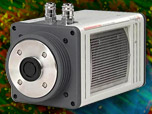Image Galleries
Featured Article
 Electron Multiplying Charge-Coupled Devices (EMCCDs)
Electron Multiplying Charge-Coupled Devices (EMCCDs)
By incorporating on-chip multiplication gain, the electron multiplying CCD achieves, in an all solid-state sensor, the single-photon detection sensitivity typical of intensified or electron-bombarded CCDs at much lower cost and without compromising the quantum efficiency and resolution characteristics of the conventional CCD structure.
Product Information
Interactive Java Tutorials
EMCCD Temperature Versus Gain
In the case of an EMCCD image sensor, the multiplication gain factor in the multiplication register greatly depends on the temperature. It is obvious that the stabilization of temperature of a sensor becomes a very important issue. This interactive tutorial demonstrates an example the dependence of gain with temperature for an E2V CCD97 CCD. A change of 70 degrees at the CCD changes the EM gain by about 10 times in the tutorial. In addition, as the temperature is decreased, the slope of the change increases. Temperature stability becomes increasingly important at lower cooling temperatures to maintain constant gain in an EMCCD.






